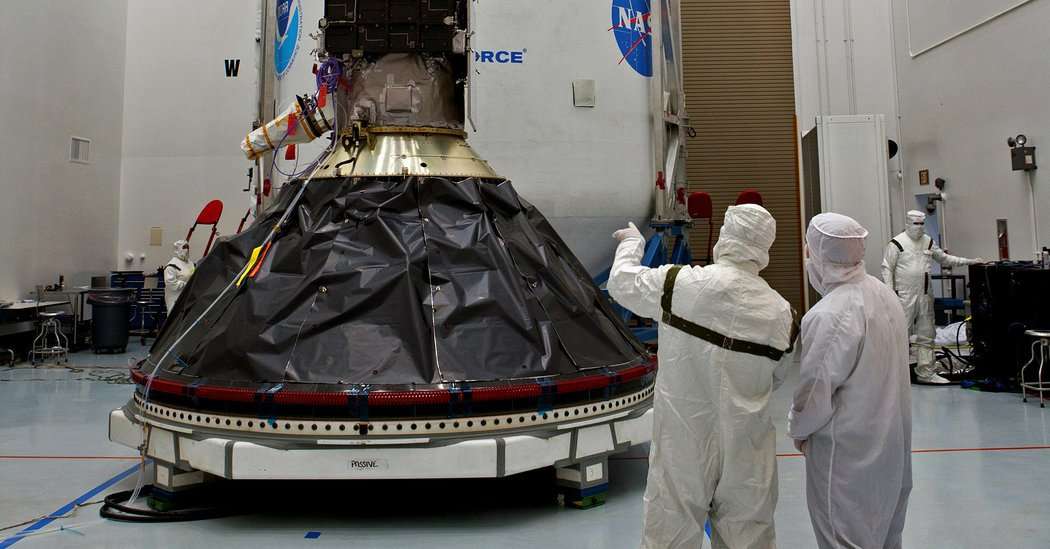In the past, NASA has built and operated climate satellites and the National Oceanic and Atmospheric Administration has operated weather satellites. While there is some overlap, weather satellites focus on basics like clouds, winds, temperatures and moisture to provide information for forecasts. Most of NASA’s instruments are designed to provide long-term records of phenomena like ice-sheet thickness, sea-level rise, vegetation changes and the makeup of the atmosphere.
NASA designed a flurry of instruments two decades ago, including about 10 that were launched aboard two satellites, Terra and Aqua. Weather satellites have been in use for about five decades and have become increasingly sophisticated.
After a scare at the beginning of this decade when it looked like NOAA might have no functioning weather satellites for a time — a potentially disastrous situation — the agency now has plans and funding to replace its satellites as required. But there are currently few plans to replace NASA’s instruments, many of which are at or near the end of their useful lives.
Advertisement Continue reading the main story
“Climate monitoring has fallen into this big gap between the agencies,” said Thomas P. Ackerman, an atmospheric scientist at the University of Washington.
The priority has been on gathering weather data,” Dr. Weatherhead said, “because we understand the value of weather data.”
That priority is reflected in the proposed Trump budget, which eliminates the NASA missions while also calling for full funding of NOAA’s replacement orbiters.
NASA officials declined to comment, but an advisory group from the National Academy of Sciences is working on recommendations for new monitoring missions for the space agency for the next 10 years. Their report is expected this year.
Even if the recommendations are adopted and new missions are funded, however, it will be years before the instruments are in orbit. That, Dr. Ackerman said, will lead to gaps in the kind of climate measurements obtained by current missions like Calipso and Cloudsat, which study clouds and atmospheric particles.
Continuous data records are crucial to climate researchers to improve their models to better understand how the climate is changing.
“We have learned an amazing amount about our atmosphere from these two instruments,” Dr. Ackerman said. “It’s a tragedy that these records will not be continued.”
As a satellite ages, project managers go to great lengths to extend its life. Byron D. Tapley, principal investigator for NASA’s 15-year-old Grace mission, which measures gravity to study variations in mass from melting glaciers and other phenomena, said that by shutting down its twin spacecraft for months at a time to protect their batteries, the mission — which is already about 10 years beyond its expected lifetime — has been extended until the end of this year.
Unlike many other NASA missions, Grace has a replacement, Grace II, which after some delays is scheduled to be launched next March. So there will only be a short data gap, said Dr. Tapley, director of the Center for Space Research at the University of Texas at Austin.
But for other missions where no replacement is in development, researchers have to seek workarounds. The Terra and Aqua satellites, for example, carry imagers that make moderate-resolution images over many wavelengths, covering the entire planet every day or two. The data has been useful in documenting changes to land, oceans and the atmosphere.
But both Terra and Aqua have been in orbit for about a decade and a half. “We’re nursing them along,” Dr. Ackerman said, by having to make difficult choices about the best ways to use the remaining fuel on the satellites. “This is not a pleasant discussion,” he added.
When both satellites are no longer working, researchers will be able to make use of an imager on a current NOAA weather satellite, Suomi NPP. But it will provide less-frequent global coverage, Dr. Ackerman said.
Of the four missions that the Trump administration wants to eliminate, one is of particular importance to researchers. The Climate Absolute Radiance and Refractivity Observatory, or Clarreo, is an imager that would be mounted on the International Space Station.
Clarreo’s main task, Dr. Weatherhead said, would be to serve as a benchmark for calibrating other orbiting instruments. That would help maintain the continuity of data from one instrument to its replacement, even if there was a long gap between the two.
Currently, to combine data from two uncalibrated instruments, researchers have to make adjustments that can render several years of data useless, Dr. Weatherhead said, adding that “We really are lost if we don’t have good calibration.”

micleddy on April 11st, 2017 at 18:09 UTC »
Anyone else think its cool the environmental monitoring climate scientists last name is Weatherhead
_beloved on April 11st, 2017 at 17:44 UTC »
Dear fellow Dinosaurs,
It is with elation that I am able to inform you that we have disassembled all meteor and interplanetary projectile research programs from the Dinosaur Global Budget. With this change we will be able to realign our focus on what really matters, like making sure that predator bellies are full and the pterodactyl nests aren't sullied by lesser airborne beasts. Our heads are placed right where they need to be. In the sand. No need to look up and wonder. No need to ask questions about the established order, or preposterous "what if" scenarios. We need to be hard focused on just today. Tomorrow, maybe. But definitely not further than a week from now. Cause it's all about getting full and getting paid, am I right folks? Of course I am.
Looking forward to keeping dinoplanet great.
Your beloved leader,
T Rex
Golanthanatos on April 11st, 2017 at 17:03 UTC »
quick rename "Climate Absolute Radiance and Refractivity Observatory" to "The best Absolute Radiance and Refractivity Observatory"